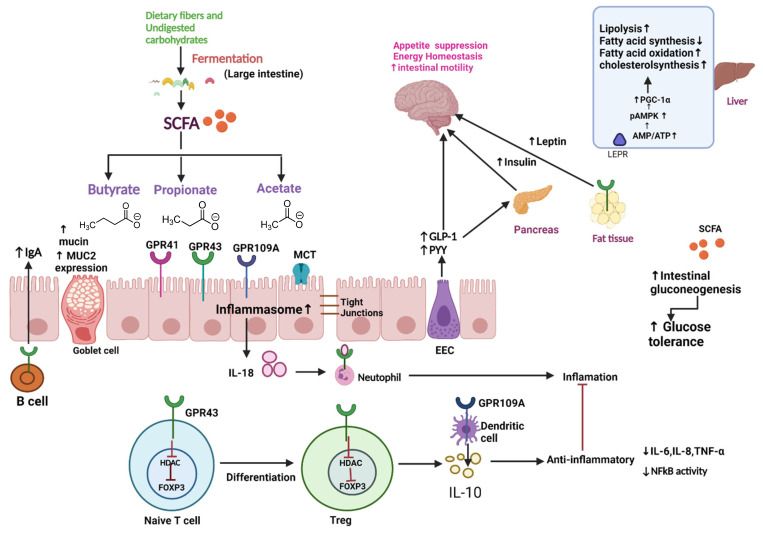Figure 2.
Schematic overview of microbiota and its metabolites—In the large intestine, dietary fiber and undigested carbohydrates are fermented into SCFA (Butyrate, propionate, and acetate) by gut microbiota. These metabolites can regulate tight junction, increase mucin production, upregulate MUC-2 expression, and increase synthesis of IgA through B cell activation. These metabolites also exert an anti-inflammatory effect by inhibiting HDAC (which leads to the differentiation of naïve T cells to regulatory T cells), which further decreases the production of proinflammatory cytokines, such as IL-6, IL-8, TNF-α, and NFkB activity. SCFA also stimulates intestinal gluconeogenesis, improving glucose tolerance. Moreover, SCFA can stimulate EEC to release GLP-1 and PYY, which acts as an anorexigenic agent by suppressing appetite and GLP-1 stimulate the pancreas to release insulin, thus increasing the uptake of glucose in muscle and adipose tissue. SCFA suppresses appetite by increasing leptin synthesis in adipose tissue. In liver SCFA, phosphorylate and activate AMPK directly by increasing the AMP/ATP ratio or indirectly via LEPR. Activation of AMPK triggers PGC-1α expression, which promotes fatty acid oxidation, lipolysis, and cholesterol synthesis and decreases fatty acid synthesis. Abbreviations: SCFA, Short-Chain Fatty Acid; MUC2, Mucin2; HDAc, Histone acetylation; EEC, Enteroendocrine cell; GLP-1, Glucagon-like Peptide 1; PYY, Peptide YY; pAMPK, phosphorylated Adenosine monophosphate activated protein kinase; AMP, adenosine monophosphate; ATP, adenosine triphosphate; LEPR, leptin receptor; PGC-1α peroxisome proliferator-activated receptor gamma coactivator 1-alpha.

